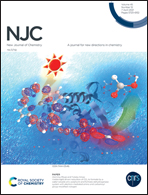Mechanistic insights of the degradation of an O-anisidine carcinogenic pollutant initiated by OH radical attack: theoretical investigations†
Abstract
O-Anisidine (O-AND) is one of the amino organic compounds that harm human health, and is considered as a carcinogenic chemical. Herein, we present a thorough theoretical investigation on the O-AND degradation mechanism initiated by the attack of an OH radical. DFT (M06-2X, M11, and MN15) and ab initio (ROCBS-QB3) methods are employed. Modern DFT functionals of Minnesota (M11 and MN15) have been benchmarked against the widely used M06-2X functional. In the course of O-AND oxidation, different pre- and post-reactive complexes for all pathways of OH additions and H-atom abstractions have been located. Rate constant calculations are obtained via the unimolecular Rice–Ramsperger–Kassel–Marcus (RRKM) and the transition state (TST) theories in conjunction with the Wigner correction (W). Branching ratio analysis indicates the domination of OH addition to the C2 atom in the applied temperature range and the average tropospheric lifetime is estimated to be 9.7 min at 272 K which illustrates fast degradation of O-AND and highlights the importance of our computational study.



 Please wait while we load your content...
Please wait while we load your content...